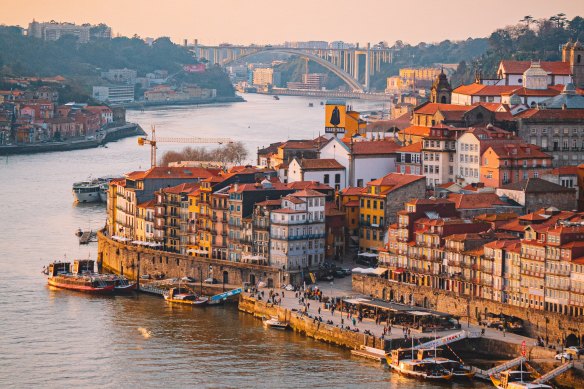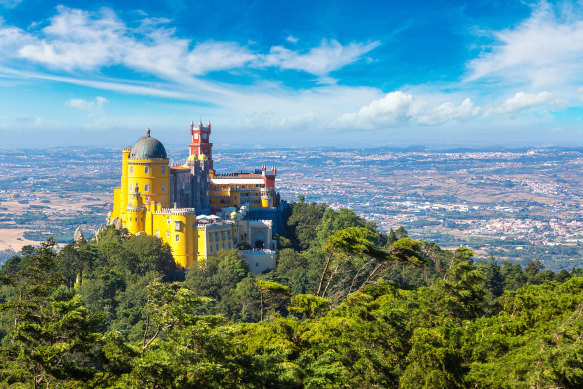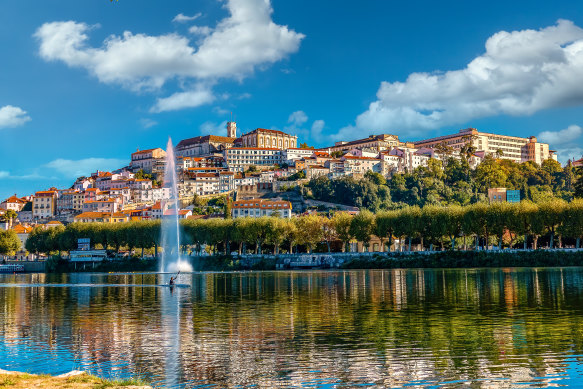
There’s ample free time to relax or explore. Away from the cities’ magnetic waterfronts, I stumble across attractive and trendy neighbourhoods – ones that elude most tourists’ radars whatever the month. In Lisbon, I linger in Principe Real, a district of handsome neoclassical mansions, leafy parks and cosmopolitan bars and eateries.

Porto and the River Douro.Credit: Woody Van der Straeten
In Porto, I find a craft ale scene bubbling with interesting brews (some matured in port wine barrels) in the lanes of Cedofeita, an arty enclave north of the historic centre. The Portuguese maintain a vibrant alfresco scene year-round, yet even on bright winter days, a chill can bite the air, especially early mornings and after sunset (some establishments have heaters, but coats are recommended if you’re drinking or dining outside).
Venturing beyond Portugal’s big two, we’re cheered by lesser-hyped cities, UNESCO-listed beauties and stunning, mountainous countryside with an evergreen tinge. The forests are still splendidly lush in Sintra, where flamboyant palaces poke through the trees. Having found it overly busy on past trips, Sintra is a breath of fresh air now. We even have the National Palace virtually to ourselves, giving us room to peruse the royal chambers, which boast some of the most spectacular azulejos in a country where almost every other building seems clad in these decorative glazed tiles.
Equally jaw-dropping is the baroque staircase of the Bom Jesus do Monte sanctuary outside the city of Braga. After rattling up to this shrine on a water-powered 19th-century funicular, we have lunch with vinho verde (fizzy young Portuguese wine) then meander down the incredible staircase on foot. It contains, they say, 573 steps, plus elaborate fountains and allegorical statues.
Coimbra is another delight. Capital of Portugal from 1139 to 1260, this city by the Mondego River is dominated by its esteemed hilltop university, which lords over a medina-esque old quarter with a gothic cathedral, tascas (taverns) and fado bars. Strolling through the university’s lovely botanical garden, my gaze is drawn to a 16th-century aqueduct built over an ancient Roman one, a slew of lofty trees (including a huge banyan from Australia) and vivid pink magnolia.
Later, I ask Rui if these blossoms are normal for February. “No, it’s too early. It’s usually in March – but, hey,” he says, nodding up at the toasty midday rays. Rui is reliably good company, enlivening coach journeys with informative, humorous commentary about Portugal’s past and present, and teaching us handy phrases, although we find English widely spoken and printed in menus (Portugal is the ninth most proficient country for English as a second language, according to the EF English Proficiency Index).

Pena National Palace in Sintra.Credit: iStock
Sometimes the window scenery hogs our attention. Especially in the Douro Valley, when we’re driving by the terraced hillsides that rise dramatically above the river. We get another perspective, cruising a converted rabelo, one of the wooden cargo boats that formerly transported wine to the cellars and warehouses of Vila Nova de Gaia, the city facing Porto across the Douro. The vineyards are bare after the recent harvest, but the scenery remains majestic, though a stiff breeze has us sheltering inside the rabelo, warmed by glasses of port.
We sample other locally crafted tipples – crisp dry whites, Provencal-style roses, bold fruity reds (and more port), almost all made with native Portuguese grapes, during our two-night stopover in the valley, the world’s oldest demarcated wine region. Our base is Quinta da Pacheca, a centuries-old estate stylishly overhauled with a spa, restaurant and hotel rooms, including some in giant wine barrels.
Activities keep us entertained. We learn how wine-making here uses methods passed through the generations. For example, before fermentation, workers still stomp the hand-picked grapes barefoot in the granite basins. We discover the joys of petiscos (Portuguese tapas) with chef Cristof. Assisted by helpers from our group, he conjures the likes of salada de polvo (boiled octopus salad) and pica-pau, which translates to “woodpecker”, with these meaty cubes, drenched in a beer, wine, brandy and tabasco sauce, typically eaten with toothpicks.

Coimbra and the Mondego River.Credit: iStock
After a week or so on the road, we also take time to wind down. When the morning mist clears, I skip past the resident peacocks and chirping blackbirds and amble through the estate’s rolling vineyards. I leaf through books in the cosy communal lounges. And I nap and sleep off a few winter sneezes and sniffles before the second leg of this tour commences. Off-season Portugal has been fabulous. And this afternoon we’ll cross the border into Spain.
THE DETAILS
Fly
Emirates flies to Lisbon from Sydney and Melbourne via Dubai. See emirates.com
Tour
Collette’s 15-day Flavours of Portugal and Spain tour departs Lisbon on dates throughout the year, ending in San Sebastian after travelling via the Rioja region. Priced from $6299 a person, this is a small-group Explorations tour (maximum 24 people per group). Several lunches and dinners with wine are included and there are optional paid-for excursions, some with meals.
See gocollette.com/en-au
FIVE OTHER HIGHLIGHTS OF PORTUGAL
Alfresco art
Portugal’s cities are de facto open-air galleries, rich in awe-inspiring art and architecture, from azulejo-covered facades and contemporary murals to ornate fountains and calcada (stone pavements with swirling mosaics).
Dining
Its colonial heritage and natural bounty of ingredients shapes Portugal’s diverse cuisine, from Goan-style fish curries at backstreet Lisbon eateries like Jesus e Goes to modern Portuguese sharing plates at Aneto, set in a restored railway warehouse in the Douro Valley town of Peso da Regua.
Surf’s up
While the country’s south-coast Algarve region is always busy with sun-seekers and golfers, the quaint fishing villages and seaside towns north of Lisbon, like Ericeira, have a sleepy charm in winter, with surfers drawn to the Atlantic swells.
Coffee
Flat whites are increasingly making waves in Portugal, with cafe-roasteries sprouting on urban streets. But sometimes traditional is best: a bica (espresso) is the perfect partner for a pastel de nata, the country’s iconic custard tart.
Markets
Revamped markets with produce stalls, hip food halls and artisan traders are fashionable in Portugal. Check out the Time Out Market and Mercado de Campo de Ourique in Lisbon, Porto’s Mercado do Bolhao and Braga’s public market.
The writer travelled as a guest of Collette.



























